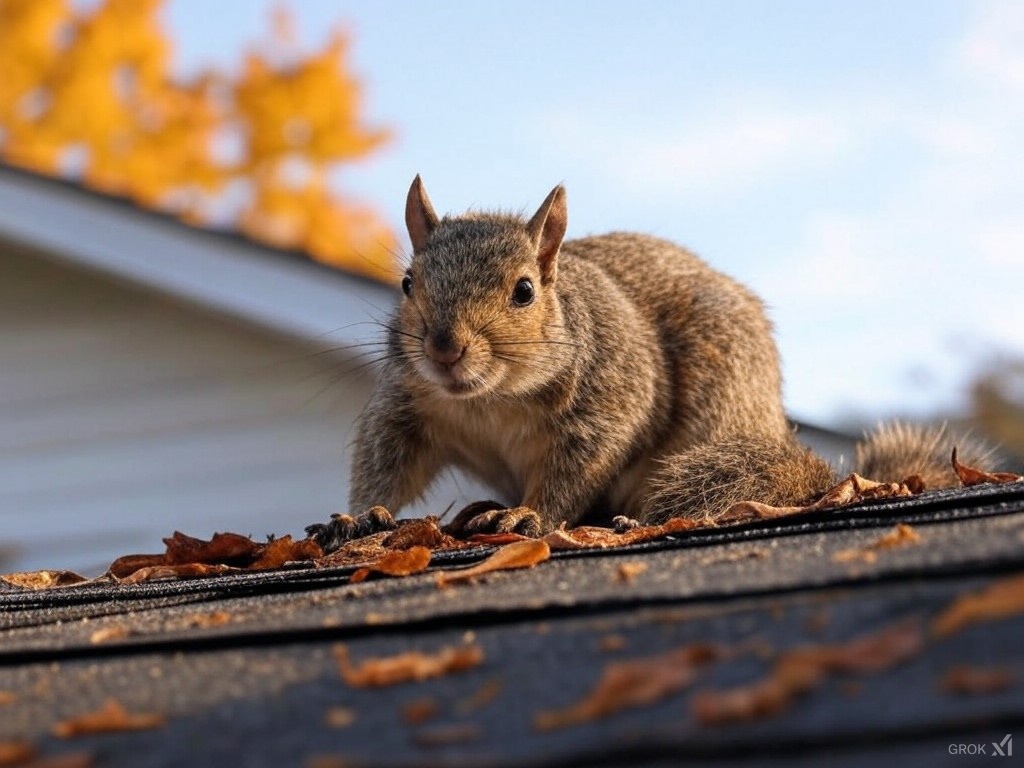Squirrels can cause a variety of damages around and sometimes inside a house due to their agile nature, sharp teeth, and need for nesting materials. Squirrel trapping is usually done at the attic entry/exit point until attic is cleared. Repairs are done so that other squirrels cannot move in.

Here’s a detailed look at the potential issues:
Structural Damage:
- Roof and Attic Access:
- Shingles and Soffits: Squirrels can chew through or dislodge shingles to access attics, leading to potential water leaks.
- Vent Screens: They might chew through or push through vent screens, compromising the integrity of the ventilation system.
- Nesting:
- Insulation: Once inside, they often shred insulation for nesting material, reducing its effectiveness and potentially causing heat loss.
- Ductwork: They can gnaw on or nest in ductwork, which can lead to blockages or damage to HVAC systems.
- Electrical Wiring:
- Squirrels chew on electrical wires, which can result in electrical shorts, fires, or power outages.
- Wood Structures:
- They can gnaw on wood framing, particularly around entry points or in attics, leading to structural weakening over time.
Property Damage:
- Gardens and Trees:
- Plant Damage: Squirrels dig for bulbs or nuts, damaging gardens. They might also eat or strip bark from young trees, which can kill them.
- Fruit Trees: They’ll raid fruit trees, eating or damaging fruit.
- Outdoor Items:
- Bird Feeders: They can destroy bird feeders or pilfer the food, scattering seeds and attracting more pests.
- Outdoor Furniture: Gnawing on or using furniture for nesting materials.
Health and Hygiene Issues:
- Disease:
- Squirrels can carry diseases like leptospirosis, salmonella, or ticks that transmit Lyme disease, posing health risks if their waste contaminates living spaces.
- Waste and Odor:
- Their droppings and urine can accumulate in attics or walls, creating unpleasant odors and potential health hazards. Urine can also promote mold growth if it soaks into insulation or wood.
- Noise:
- The scampering, gnawing, or vocalizations of squirrels in walls or attics can be quite disruptive, especially during their active hours.
Additional Concerns:
- Water Damage: Entry points created or enlarged by squirrels can lead to water infiltration during rain or snowmelt.
- Food Storage: If they get into a home, they might store food in walls or attics, attracting insects or leading to rot.
Mitigation:
- Seal Entry Points: Use durable materials to close off any potential entry points.
- Tree Trimming: Keep branches trimmed away from the roof to reduce access routes.
- Trapping: For squirrels inside structures, traps or one-way devices can be used.
- Repellents: There are various repellents, though their effectiveness varies.
- Squirrel-Proofing: Use squirrel-proof bird feeders or protect garden areas with netting.
Addressing squirrel damage often requires a combination of preventative measures and, in some cases, professional pest control services to ensure humane and effective management. Remember, while squirrels are cute, they can become significant pests if they take up residence in your home.
